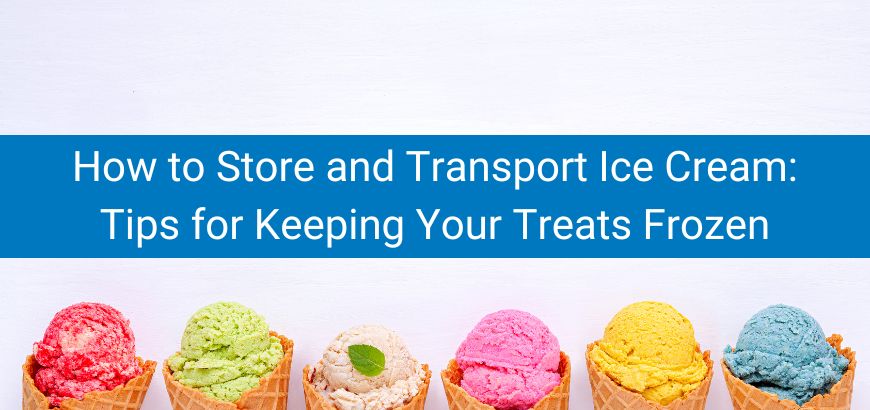How to Store and Transport Ice Cream: Tips for Keeping Your Treats Frozen

Admin
July 17, 2022


July 17, 2022

No matter the season, ice creams are a crowd-pleaser. Whether it is served in a tub, cone, popsicle or sticks, it is enjoyed by all age groups alike. It is evident from the fact that the global ice cream market was estimated to be at USD 71.52 billion in 2021. Moreover, similar to the food industry which is occupied with health trends, the ice cream sector is not far behind. There is an increasing interest in fortified, low-fat, vegan ice creams as well as new innovative flavours that are driving the demand. With that being said, the adoption of effective cold chain solutions for the transportation and storage of ice cream remains the top priority of manufacturers and suppliers.
As a perishable food item, your frozen treats very much rely on refrigerated trucks for transportation and cold storage to maintain the quality, taste, and texture until they reach the supermarkets and finally the customers. Let us understand more about how ice cream businesses can make the most of cold chain solutions.
First ice cream appeared in ancient Persia some 2500 years ago. At that time, ice creams were all based on the sweetened water that was iced, ground into little pieces and then decorated with various tasting fruits & toppings. We know that Alexander the Great enjoyed snow and ice flavored with honey and nectar. Biblical references also show that King Solomon was fond of iced drinks during harvesting. During the Roman Empire, Nero Claudius Creaser (A.D.54-86) frequently sent runners into the mountains for snow, which was then flavored with fruits and juices.
Over a thousand years later, Marco Polo returned to Italy from the far east with a recipe that closely resembled what is now called sherbet. Ice cream was known in England in the early 1700s but was still a rare item when served in the United State to White House guests by Dolly Madison in 1809. Today, ice cream is the favourite sweet dish across all age groups.
Ice cream is primarily composed of milk fat (butterfat) and milk solids-non-fat (MSNF), sugar, stabilizer, emulsifier, flavouring compounds, water, and air.
The combination of these components before the air is incorporated and the mixture frozen is known as the ice cream mix. The mix composition may be made richer or leaner in fat MSNF and total solids, depending on market requirements in typical commercial operations. The supply and cost of dairy ingredients vary throughout the year, and so the ice cream plant manager frequently adjusts mix formulas to keep the overall ice cream composition constant at the best possible cost.
A good average ice cream would contain about 12% milkfat, 11%MSNF, 15% sugar, 0.2% stabilizer, 0.2% emulsifier and a trace of vanilla, resulting in 38.4% total solids and the remaining water. To this other ingredients such as nuts, fruit, chocolate, egg, and additional flavourings can be added. Delux and French ice creams may have 18% fat; economy ice cream, 10% fat; and ice milk products only about 4% fat.
Milk fat is the most expensive major ingredient of ice cream and so the higher the fat content, the more expensive the product. State and federal regulations covering compositions of frozen desserts are largely based on milk fat and total milk solids content. For example, according to federal standards, plain ice cream may contain no less than 10% milk fat and 20% total milk solids whereas fruit, nut or chocolate ice creams may contain no less than 80% milk fat and 16% total milk solids. There are also allowances for other ingredients. Products with leaner compositions may not be called ice cream.
Each of the major ingredients in ice cream serves specific functions in the final product.

When ice cream is drawn from the freezer, it is put into containers that give it the desired form and size for convenient handling during the hardening, storage, shipping, marketing and selling.
Ice cream is a perishable product and should be handled carefully. When frozen desserts are exposed to temperatures above 100°F they become subject to adverse changes in texture and flavour characteristics. Stored ice cream should never reach above 0°F. The ideal temperature for long-term storage is -100°F and -200°F. Ideally, ice cream should be stored in a specially designed cold warehouse, ice cream freezer or display cum freezing unit when at the supermarkets.
The long-distance transportation of ice cream is presently being done in India, by refrigerated trucks also known as reefers. Therefore, the life of the commodity while in transit depends on the quality of the equipment of the refrigerated truck and its operational productivity. The essential low temperature of less than or equal to -22°F is also required to be maintained while the product is transported from one place to other.
However, there remains a challenge with reefer trucks—environmental impact and fuel efficiency, especially in secondary transportation or last-mile delivery. This is where eutectic refrigerated trucks offer a greener and more efficient cold chain logistics solution.
Rinac has innovatively designed cold chain storage and logistics solutions for the ice cream industry including
To know more about our specially designed cold chain solutions, contact us today!